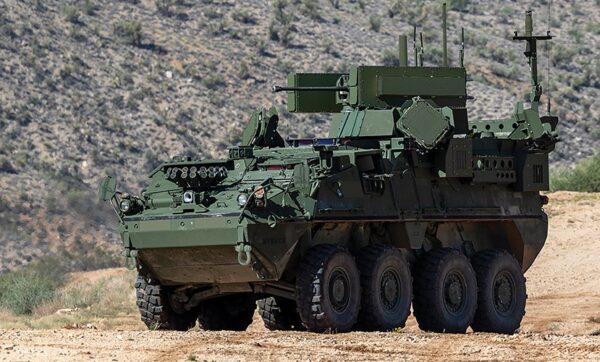
By John Knowles
As the House and Senate return to Capitol Hill this month, they will continue working on the FY25 National Defense Authorization Act (NDAA), which includes several provisions focused on counter-unmanned aerial systems (C-UAS) technology, procurement, and strategy.
The House narrowly passed its version of the NDAA (H.R. 8070) on June 14, and the Senate Armed Services Committee (SASC) completed the mark-up on its version of the bill (S. 4638) on July 8, although the bill had not been sent to the Senate floor for debate before the House and Senate entered their month-long August recess.
Even more than last year’s NDAA, lessons from the from Russian-Ukrainian War, seemed to influence this year’s NDAA legislation. Both versions of the bill and their accompanying committee reports contain many counter-UAS provisions.
The committee report (118-529) accompanying the House version of the bill contains several sections focused on the DOD’s plans to field C-UAS capabilities in the coming years. In the Army procurement section of the report, for example, the HASC noted “the current and emerging threat small drones pose to soldiers and formations” and adding, “Drones are now part of all future conflicts regardless of theater. Therefore, the Army must field C–UAS capabilities as quickly as possible to protect all maneuver forces and facilities.” While noting that the Army is pursuing the Mobile, Low, Slow, Small Unmanned Aircraft Integrated Defeat System (M–LIDS) on Stryker vehicles to protect echelon-above-brigade (EAB) units, “the committee has not seen the urgency to design, develop, test, and field mobile C–UAS capabilities for mounted Brigade Combat Teams (BCTs) and below.” The HASC called for a briefing from the Secretary of Defense by December 1 to describe the DOD’s plans to field “a single vehicle C–UAS capability for mounted BCT formations and below.”
In the Defense-Wide procurement section, the HASC committee report states, “The committee remains concerned about the proliferation of small unmanned aircraft systems (UAS) and the capacity and capability of the Department of Defense to defend a ‘covered facility or asset.'” The language calls on the Secretary of Defense to provide a briefing to the HASC by January 1 providing a list of “concerning UAS events” at military installations; a list of approved counter small UAS (C-sUAS) capabilities cleared for use at military installations; a list of C-UAS assets at US military installations and a list of military facilities that do not meet the definition of “covered facility or asset.” The gist of this language is to get a handle on how the DOD can better protect its facilities from small UAS threats.
The same concern was raised in the SASC report (118-188), Section 1057, which requires the Secretary of Defense to “…develop a strategy for countering unmanned aircraft systems (UAS) technology and the threats such technology poses to facilities, personnel, and assets of the Department of Defense (DOD) overseas and in the United States.” In addition it calls for a report on the strategy; an assessment of resources and authorities needed to protect overseas operations of US forces; determine how to “pre-coordinate” with other federal agencies to respond to UAS incursions; and authorize the Secretary of Defense to “…to provide support to Federal, State, and local government agencies for detecting, identifying, and monitoring unmanned aircraft systems that cross the Northern and Southern borders of the United States.” The provision also calls for the DOD to provide a comprehensive assessment of C-UAS systems in development or fielded to that Armed Forces by January 1, including a review of the numbers, value and efficacy of the systems “…broken down by sensing, characterization and engagement capabilities.”
In a separate provision, the SASC report stated, “The committee recommends a provision that would require the Secretary of Defense to establish a counter-unmanned aircraft system (C-UAS) task force which shall, in conjunction with the Chairman of the Joint Chiefs of Staff, review, update, and consolidate memoranda and directives related to C-UAS authorities. The provision would also require each commander of a military installation, following the review, to update and consolidate memoranda and directives and to issue standard operating procedures for C-UAS at each installation.” It also directed the Chairman to provide a briefing by June 1, 2025, “on all actions taken by the C-UAS task force to review, update, and consolidate memoranda and directives related to C-UAS authorities.”
In a separate provision (Section 1058), the SASC requires the Secretary of Defense, “…in coordination with the Chairman of the Joint Chiefs of Staff and the Commander, U.S. Northern Command, to plan and execute a full-scale counter unmanned aerial system response exercise in the Department of Defense’s special use airspace. The provision would also require the Secretary of Defense to provide a briefing to the congressional defense committees on the outcomes and lessons learned from the exercise.”
Countering drone swarms was another area of interest for the HASC and the SASC. Under a provision titled, ” Counter swarm real-time on demand engagement orchestration” the HASC report notes that current UAS swarming capabilities are “relatively simple.” However, “…the committee believes that emerging artificial intelligence (AI) and low-cost manufacturing is going to change the nature of this environment.” It states, “To defeat this threat, the committee believes a reactive command and control (C2) capability to detect the swarm and then to allocate available re- sources, such as gun, missile, and electronic attack effectors, will be necessary.” It expresses support for “Real-time On Demand Engagement Orchestration (RODEO) as an adjunct, trusted AI driven C2 capability to continually monitor and detect a sUAS swarm.”
The SASC report, in a provision titled, “Directed energy protection capability,” stated, “The committee remains concerned about the threat posed by low-cost attritable aerial drones, especially the threat that drone swarms pose to our forces. The committee notes that conflicts in Ukraine and the Middle East clearly demonstrate the utility and proliferation of low-cost attritable aerial drone systems and believes that more must be done to protect U.S. servicemembers from that threat. The committee welcomes the resulting increase in focus of the Department of Defense (DOD) on exploring the use of directed energy systems to defeat these threats at a low cost per engagement. The committee encourages DOD to prioritize rapidly developing and acquiring directed energy systems to defeat large drone swarms and believes that the Department should utilize all available rapid acquisition pathways to develop and acquire directed energy counter drone swarm systems. Furthermore, the committee directs the Secretary of Defense to provide a briefing to the Committees on Armed Services of the Senate and the House of Representatives, not later than February 1, 2025, on all efforts to develop and procure directed energy systems to defeat large numbers of drones in a single engagement.”
In a separate provision titled, ” Directed energy testing for countering unmanned aerial systems,” the SASC states, that it “…recognizes the threat posed by Group 1 to Group 3+ unmanned aerial systems (UAS) and UAS swarms, both to the Homeland and to U.S. military operations, installations, and personnel worldwide. The committee understands that to defeat this growing threat, a layered, integrated defense strategy is required that includes directed energy (DE) capabilities. The committee recognizes that DE capabilities must be tested and servicemembers must be trained in their operation before they can be deployed against UAS and UAS swarms.” It calls for the Secretary of Defense “to submit a briefing to the congressional defense committees, not later than March 31, 2025, on the current capability of the Department of Defense (DOD) to test DE systems and plans to increase that capability.” The briefing should include a list of DOD test ranges that can evaluate DE systems, an assessment of “…existing Federal Aviation Administration (FAA) and National Telecommunications and Information Administration (NTIA) policies and regulations relevant to the testing of DE systems and the use of spectrum analysis tools,” as well as “…an assessment of the potential impacts of DE system tests on the National Airspace System and the electromagnetic spectrum, particularly concerning effects beyond these installations’ fence lines” and “…a plan to expand range support for DE testing and operations.”
The House and Senate, respectively, will reconvene on September 9 and are expected to name a conference committee to hash out the differences in their separate NDAA bills and present each chamber with a unified bill for a vote.



